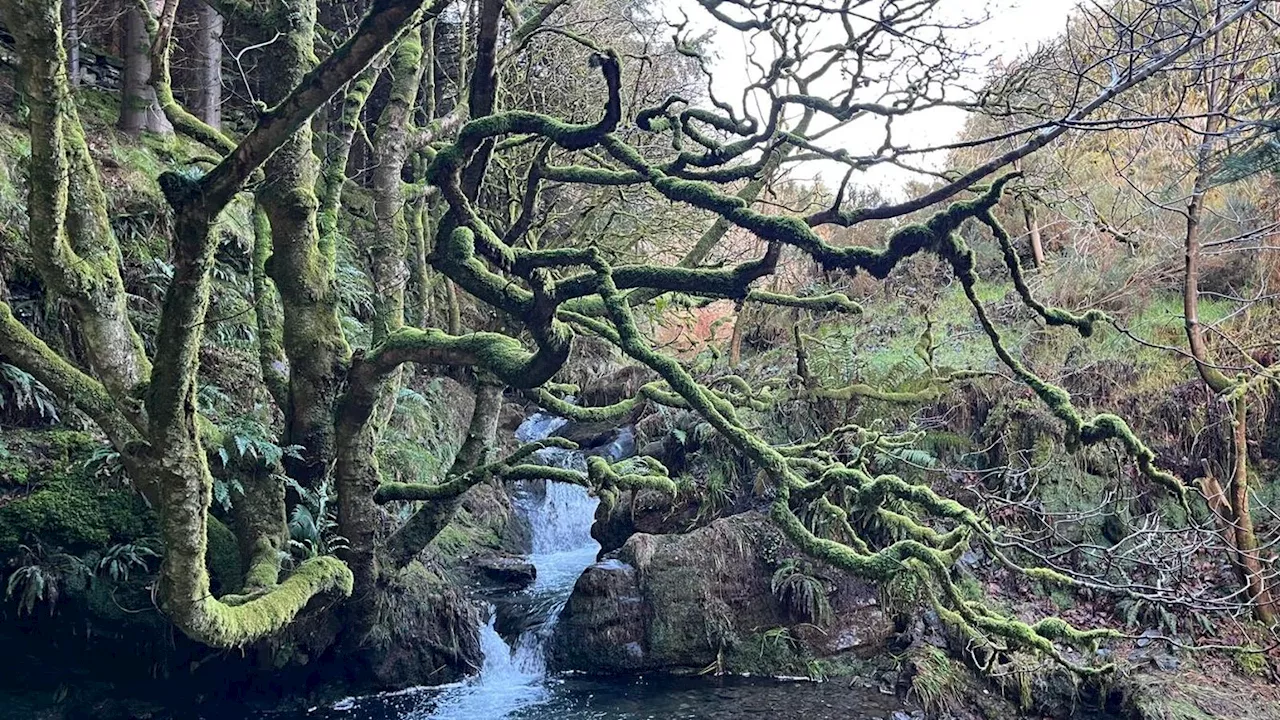Sites such as a new nature reserve at Glion Darragh are being restored to temperate rainforests, to benefit biodiversity and climate adaptation.
When Andree Dubbeldam stands under a row of identically tall, spindly Sitka spruce trees, of course he sees lots of conifers, which decades ago were brought from the Pacific Northwest. That’s some 4,000 miles away from the Isle of Man, a crown dependency of the UK located between England and Ireland. The isle’sThere are the trees Dubbeldam sees now, and the ones he sees in his mind’s eye. For Dubbeldam also keeps in mind what the 174-acrecould look like a few decades on.
Some of this may seem like a pipe dream. Replanting in this gentle valley hasn’t yet started in earnest. Dubbeldam, a woodlands wildlife officer for the Manx Wildlife Trust, hopes that in about 15 years the land will be stocked with cows that produce less methane when they belch, though it’s not yet clear. He thinks that rewilding of this site can coexist not only with some grazing, but also with a thinned-out forest of conifers and more local trees, and perhaps some thoughtful nature tourism.
Yet it aligns with the pragmatic approach of the Manx Wildlife Trust, the NGO that manages the Glion Darragh Nature Reserve, as well as others dotted around the island. A nature supporter gifted this land to the trust in 2024, following the passing of her father. It was marginal land that had already been on sale for years, according to Graham Makepeace-Warne, the head of engagement at the Manx Wildlife Trust. So protecting this land hasn’t removed it from productive use, he says.
That’s the main quarrel of opponents of such conservation projects. Farmers are anxious about the loss of farmland, and the Manx National Farmers’ Union has. However, the union says that it has no specific concerns about converting monoculture coniferous plantations to native trees, as at the Glion Darragh site.Diversifying forests would help respond to tree diseases, Dubbeldam notes, while expanding forests would help the island absorb more water overall.
There’s one part of the reserve that already resembles what Dubbeldam hopes the rest will eventually look like. At the edge of the conifer forest and overlooking a stream, soft, Grinch-green moss has started to return to the spruce trees. Occasionally there’s a small fern. It’s a striking difference from the dark, uniform rows of trees behind. This area looks “ancient and gnarly and Tolkien-esque,” as Dubbeldam describes it.
Temperate Rainforest Celtic Rainforest Rewilding Wildlife Trust
United States Latest News, United States Headlines
Similar News:You can also read news stories similar to this one that we have collected from other news sources.
Georgia Tech Legend Calvin Johnson on Brent Key: 'He is Bringing That Program Back'Last Saturday, Georgia Tech pulled off one of the biggest wins of the year when they upset Miami, giving them their first loss of the year. Not only that, but t
Read more »
 McDonald's is bringing back $1 items as part of its new 2025 value menuMcDonald's is doubling down on value in 2025 as it continues to entice cost-conscious diners.
McDonald's is bringing back $1 items as part of its new 2025 value menuMcDonald's is doubling down on value in 2025 as it continues to entice cost-conscious diners.
Read more »
 Trump Is Bringing Back Economic PatriotismPresident-elect Trump campaigned on the promise of raising tariffs across the board, and he has a mandate to deliver protection and prosperity.
Trump Is Bringing Back Economic PatriotismPresident-elect Trump campaigned on the promise of raising tariffs across the board, and he has a mandate to deliver protection and prosperity.
Read more »
 McDonald's is bringing back a festive dessert – but not everywhereMcDonald's is bringing back its festive Holiday Pie to the menu in certain U.S. cities.
McDonald's is bringing back a festive dessert – but not everywhereMcDonald's is bringing back its festive Holiday Pie to the menu in certain U.S. cities.
Read more »
 Invincible Season 3 Is Thankfully Bringing Back Season 2's Most Underused SuperheroMark posing in his blue suit in Invincible season 3
Invincible Season 3 Is Thankfully Bringing Back Season 2's Most Underused SuperheroMark posing in his blue suit in Invincible season 3
Read more »
 Starbucks is bringing back old-school feature customers have demanded for years: ‘I miss those days’Starbucks is going back to the future.
Starbucks is bringing back old-school feature customers have demanded for years: ‘I miss those days’Starbucks is going back to the future.
Read more »
